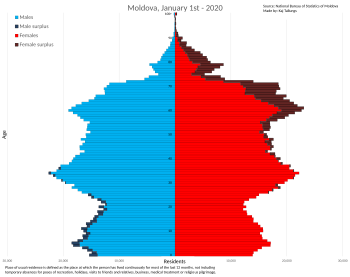
Back Насельніцтва Малдовы Byelorussian Население на Молдова Bulgarian মলদোভার ভাষা Bengali/Bangla Obyvatelstvo Moldavska Czech Demografía de Moldavia Spanish Démographie de la Moldavie French Stanovništvo Moldavije Croatian Demografi Moldova ID 몰도바의 인구 Korean Moldavijos demografija Lithuanian
| Demographics of Moldova | |
|---|---|
 Moldova population pyramid in 2020 | |
| Population | |
| Density | 85.6 (excluding Transnistria) (2021) |
| Growth rate | −0.3 (2016) |
| Birth rate | 10.5 births/1,000 population (2016) |
| Death rate | 10.8 deaths/1,000 population (2016) |
| Life expectancy | 73.21 years (2017) |
| • male | 69.35 years (2017) |
| • female | 76.96 years (2017) |
| Fertility rate | 1.57 children born/woman (2018) |
| Infant mortality rate | 9.4 deaths/1,000 live births (2017) |
| Net migration rate | +0.0 migrant(s)/1,000 population (2012) |
| Age structure | |
| 0–14 years | 16.4% (male 301,150/female 284,400) |
| 15–64 years | 73.6% (male 1,277,900/female 1,341,650) |
| 65 and over | 10.0% (male 133,060/female 222,270) |
| Sex ratio | |
| Total | 0.91 male(s)/female (2008 est.) |
| At birth | 1.06 male(s)/female |
| Under 15 | 1.06 male(s)/female |
| 15–64 years | 0.94 male(s)/female |
| 65 and over | 0.59 male(s)/female |
| Nationality | |
| Nationality | Moldovans |
| Major ethnic | Moldovans 75.1%[2] |
| Minor ethnic | Romanians 7.0%, Ukrainians 6.6%, Gagauz 4.6%, Russians 4.1%, Bulgarians 1.9% |
| Language | |
| Official | Romanian language |
| Spoken | Romanian, Russian, Gagauz |
Demographic features of the population of Republic of Moldova include distribution, ethnicity, languages, religious affiliation and other statistical data.
- ^ "Population with usually resident population by sex and age group in territorial profile on 1 January 2024". 10 June 2024. Archived from the original on 11 June 2023. Retrieved 11 June 2023.
- ^ 2014 Moldovan census